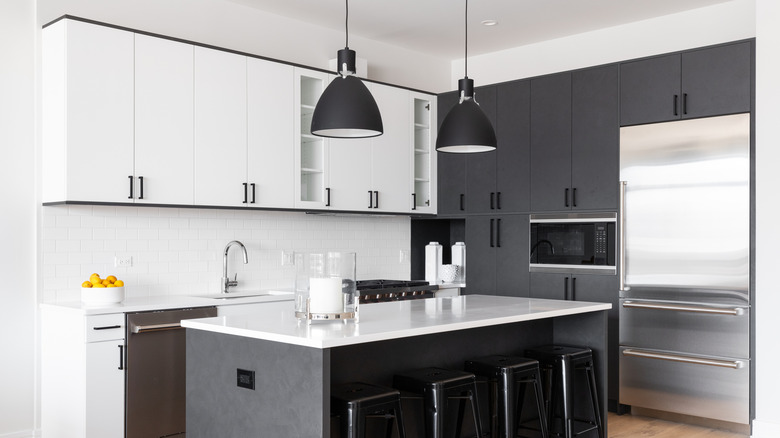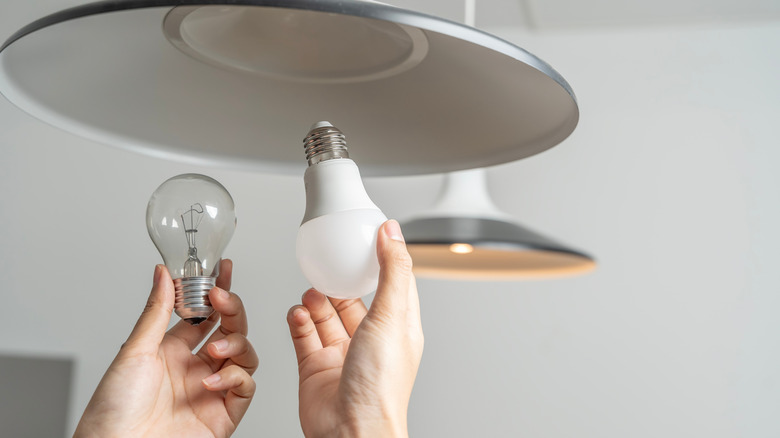We may receive a commission on purchases made from links.
Kitchens are one of the most utilized spaces in the home, but thanks to all the edges, nooks, and crannies, they can lean dark without the proper lighting. Figuring out
the best type of lighting to use in your kitchen
can be overwhelming to say the least. To make it easy, Mike Holmes, host of HGTV’s “Holmes on Homes,” recommends a layered lighting approach to brighten up a dark kitchen.
“The best way to light your space is to use a combination of different lights,” Holmes shares on his website,
Make It Right
. “Different lighting sources will allow you to create functional and aesthetically pleasing space that suits today’s busy kitchens.” He suggests having three minimum light source types to brighten a dark kitchen: overhead, accent, and task lighting. Overhead lighting acts as an all-purpose brightener, accent lighting highlights specific areas or elements, and task lights make it easy to see what you’re doing, like chopping carrots or reading through that recipe.
Read more:
HGTV’s Nate Berkus Shares A Small But Mighty Essential For Home Security
How To Use The Three Types Of Lighting To Brighten A Dark Kitchen

When you’re
planning your kitchen’s lighting layout
, it’s important to account for all three lighting sources. First, flip on the overhead light. Is it sufficient to see and move safely in the space? If not, consider adding more overhead lighting. Next, notice where you do your prep work, especially if you’re upgrading the lighting in an existing kitchen. Knowing your go-to spots to meal plan or prep dinner will help you identify where you need more focused light. Then, step back and assess your kitchen. Where could you add some accent lighting to brighten the space and atmosphere? Think wall sconces, uplights, or even over-cabinet lighting. Finally, assess the natural light in your kitchen. Knowing where it falls during the day can help you appropriately brighten a dark kitchen after sunset.
Now that you know where you want light and where it’s lacking, consider what kind of light fixtures to add. Pendant lights are a great overhead option. They can be easily rotated out when you want to switch up décor, and can act as both task lighting and all-purpose lighting. For task lighting, under-cabinet lighting is great to add in during construction to minimize wires, but if that’s not possible, rechargeable LED lights like
MCGOR Under Cabinet Lighting
will do the trick. Recessed lighting, like
Meconard Ultra-Thin LED Recessed Ceiling Light
, can help brighten the overall space. Just make sure to space them out at least four feet for maximum light distribution.
The Top Thing To Keep In Mind To Pull Your Kitchen Lighting Together

Different areas in your kitchen need different light and therefore, different light bulbs. Think about it: You probably want a bright white light during meal prep, but not so much in the breakfast nook. As a general rule of thumb, use cooler lights in work areas and warmer lights to create atmosphere. Not sure how to tell which bulb is which tone? Check the Kelvin rating on the bulb box. The lower the number, the warmer the light.
A brief walk through the lighting section at your local hardware store reveals that choosing a light bulb involves decisions beyond simply selecting the Kelvin rating. A major consideration is the type of light bulb itself. Options range from halogens to fluorescents, yet Holmes suggests opting for LEDs. He explains this preference because “LEDs work well with dimmer switches and consume approximately twenty percent less power.” Furthermore, he notes in his article, “While LEDs might have a higher upfront cost, they ultimately pay off. The savings on electricity bills far outweigh the initial expense. By making the transition to LEDs, you contribute positively to both environmental conservation and financial management.”
Ultimately, for consistent lighting throughout the kitchen, Holmes suggests using bulbs from just one manufacturer. It might seem excessive, but it does make a significant difference.
illumination error that gives your kitchen an appearance of dreariness and fatigue
Not utilizing the appropriate colored light bulbs can be an issue. Opting for bulbs from the same manufacturer guarantees that the hues of the lights work well together, transforming your formerly dim kitchen into a cozy, inviting area.
Liked this article? Receive professional home tips, DIY tutorials, and design ideas by subscribing to the service.
House Digest newsletter
!
Read the
Original Article from House Digest
.


